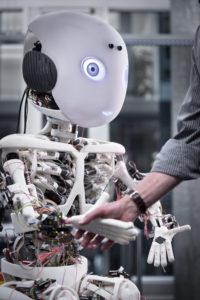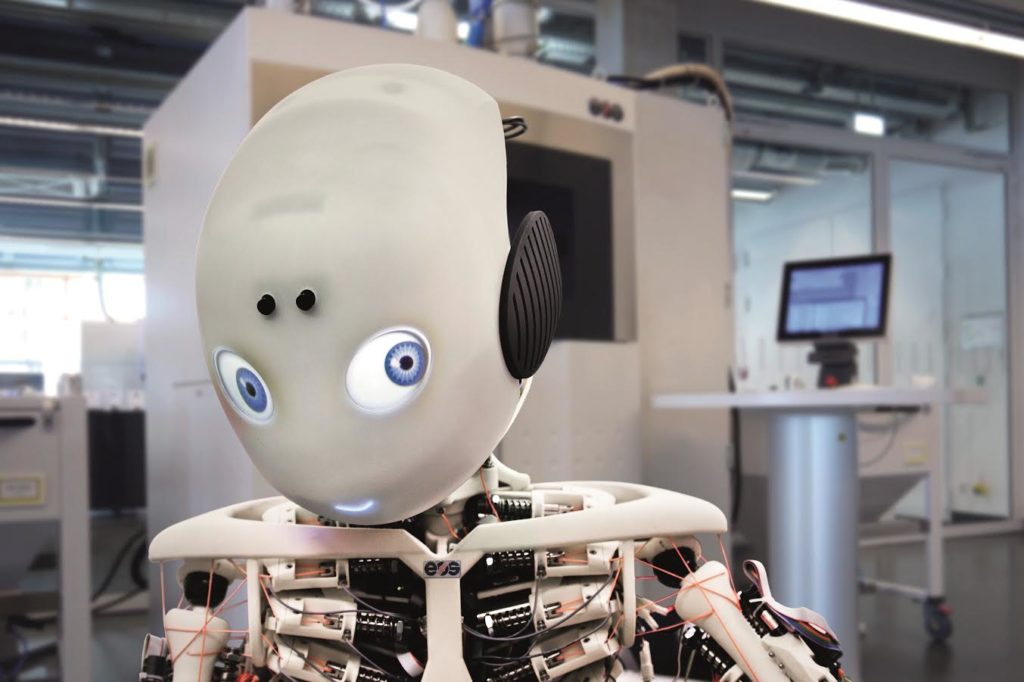 The award-winning industrial additive manufacturing solutions company EOS e-Manufacturing Solutions is undoubtedly a global leader in the world of 3D printing, with its innovative MeltPool Solution and a recently announced metal 3D printing partnership with Audi. The German company is a pioneer in holistic additive manufacturing solutions. This week, EOS announced that it will be supporting, and sponsoring, Swiss nonprofit society Devanthro and its latest research project, Roboy, at the Technical University of Munich (TUM) – an institute that recently teamed up with two other universities to develop a lightweight 3D printed infill inspired by bone structure.
The award-winning industrial additive manufacturing solutions company EOS e-Manufacturing Solutions is undoubtedly a global leader in the world of 3D printing, with its innovative MeltPool Solution and a recently announced metal 3D printing partnership with Audi. The German company is a pioneer in holistic additive manufacturing solutions. This week, EOS announced that it will be supporting, and sponsoring, Swiss nonprofit society Devanthro and its latest research project, Roboy, at the Technical University of Munich (TUM) – an institute that recently teamed up with two other universities to develop a lightweight 3D printed infill inspired by bone structure.
The Roboy project is focused on using 3D printing technology to advance humanoid robotics to the full capabilities of the human body, by replicating the human musculoskeletal system. The plan is to continue improving the models of Roboy iteratively, until he (it seems to me that Roboy is a boy) is able to perform in a way that’s “comparable to humans in dexterity, robustness and flexibility.” The first prototype was called Roboy Junior and was developed in just nine months several years ago. Roboy’s complete skeletal body structure was created using EOS systems for plastic additive manufacturing. Instead of motors, Roboy Junior actually has muscles and tendons in his joints.
 Devanthro is the Society for the Development of Anthropomimetic Robots (say that five times fast!), which came about after a Swiss law that supported developing robots that can really imitate the human body. All of the Roboy platform’s research efforts are coordinated by the society, and according to its website, the support is focused on all relevant areas for humanoid robots, but most especially on the following:
Devanthro is the Society for the Development of Anthropomimetic Robots (say that five times fast!), which came about after a Swiss law that supported developing robots that can really imitate the human body. All of the Roboy platform’s research efforts are coordinated by the society, and according to its website, the support is focused on all relevant areas for humanoid robots, but most especially on the following:
- Biomimetic musculoskeletal mechanics
- Control of systems with many degrees of freedom and complex dynamics
- Human-robotics interaction
- Learning and developmental robotics
- Care and service robotics
 Additive manufacturing was the clear choice for the Roboy project, as it allows for the construction of complex structures, with a reduced building complexity due to the layer-by-layer process, that are also stable and lightweight. Small batch sizes can be manufactured at low cost, with fewer assembly steps, and the degree of design freedom and integration of functional features is high, all of which is very helpful for the Roboy team. Roboy’s forearms and hands, including several joints and individual phalanxes for each of his fingers, can be additively manufactured in one piece.
Additive manufacturing was the clear choice for the Roboy project, as it allows for the construction of complex structures, with a reduced building complexity due to the layer-by-layer process, that are also stable and lightweight. Small batch sizes can be manufactured at low cost, with fewer assembly steps, and the degree of design freedom and integration of functional features is high, all of which is very helpful for the Roboy team. Roboy’s forearms and hands, including several joints and individual phalanxes for each of his fingers, can be additively manufactured in one piece.
Additive manufacturing allows the development team to test Roboy themselves, thanks to its fast manufacturing of separate components, which allows for iterative hardware development. Simulations don’t work when the team needs to validate project requirements, because of Roboy’s “maximal mechatronic complexity on a minimal space.”
“In software development, rapid development cycles allow software improvement by testing it ‘in the wild.’ Additive Manufacturing allows us to apply this approach to robotics, enabling a rapid development to find optimal functional parts in a fraction of the time,” said Rafael Hostettler, Roboy project leader. “EOS’ AM technology is a key component for doing this as it enables the iterative hardware development that is crucial for our project.”
 As advancements in robotics and artificial intelligence continue, robots could eventually be much more prominent in our society, taking on repetitive and possibly dangerous tasks. So it’s advantageous to build robots that have a similar morphology to humans: it can help make interactions between man and machine more natural and intuitive, and humanoid robots will likely need less expensive adaptions if it can easily fit into our environment. In terms of actually building the robots, it’s been proven that more robust and dexterous robots can be developed when basing them off of the musculoskeletal system of a human. In addition, robots that are compatible with the anatomy of humans can help scientists determine how best to repair human mobility, in terms of using prosthetics and exoskeletons.
As advancements in robotics and artificial intelligence continue, robots could eventually be much more prominent in our society, taking on repetitive and possibly dangerous tasks. So it’s advantageous to build robots that have a similar morphology to humans: it can help make interactions between man and machine more natural and intuitive, and humanoid robots will likely need less expensive adaptions if it can easily fit into our environment. In terms of actually building the robots, it’s been proven that more robust and dexterous robots can be developed when basing them off of the musculoskeletal system of a human. In addition, robots that are compatible with the anatomy of humans can help scientists determine how best to repair human mobility, in terms of using prosthetics and exoskeletons.
According to an Affectiva article found on Roboy’s very own Facebook page (check out his relationship status for a good laugh), Roboy is also a soft robot research platform for studying how muscles coordinate, and he’s the first anthropomimetic robot to have a place in the Human Brain Project (HBP). If you don’t think Roboy is human-like yet, wait until you hear this: a winning team at a Roboy hackathon used Affectiva’s software development kit to detect the emotions of people Roboy was in contact with – and then Roboy actually reacted to the emotions!
“While a large number of companies focuses on AI development, only a very small number of projects worldwide develop humanoid robotics,” said Dr. Adrian Keppler, Chief Marketing Officer at EOS. “Therefore, we are all the more proud to support the renowned Roboy project and see its meaning. As the strengths of Additive Manufacturing lie in those areas where conventional manufacturing reaches its limitations, EOS’ technology is the ideal solution for a research project as ambitious as Roboy. We are happy that the Roboy team is trusting in EOS to realize their vision.”
Discuss in the Roboy forum at 3DPB.com.
We have reached out to EOS for comment on their role in this project, and will update upon hearing back from them.
Subscribe to Our Email Newsletter
Stay up-to-date on all the latest news from the 3D printing industry and receive information and offers from third party vendors.
You May Also Like
High Stakes, High Speed: KVG Acquires 15 Nexa3D HSE 3D Printers to Boost Military Tech
As 3D printing increasingly intersects with defense and military logistics, a new partnership between Nexa3D and mission support logistics firm KVG stresses the growing importance of this technology in strategic...
3D Printer Maker EVO-tech Reborn as NEVO3D — Once More With Feeling
EVO-tech was a 3D printing service and original equipment manufacturer established in 2013 and based in Schörfling am Attersee, Austria. The company produced high-quality material extrusion systems featuring linear bearings,...
3D Printing News Briefs, March 16, 2024: Partnerships, Affordable Bioprinter, & More
We’re starting with dental 3D printing news today, and then moving on to some new partnerships. Then it’s on to some interesting university research about 3D printing plant-based pharmaceuticals, but...
FDR vs. SLA: The Right Polymer Manufacturing Choice for Your Application
The additive manufacturing (AM) industry has no shortage of acronyms when it comes to the various methodologies of industrial 3D printing. In polymer 3D printing, there are three main methods...



![[Image: Affectiva]](https://3dprint.com/wp-content/uploads/2017/02/Roboy-emotions.png)





























